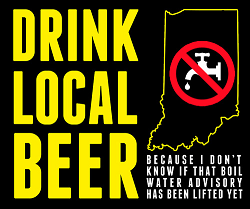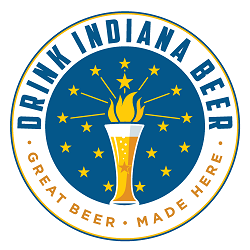The newspaper of record for New Albany (NABC's home town) and Jeffersonville (where Red Yeti and Flat12 new taproom are located) is called the News and Tribune. It is a branch of the CNHI national tree.
Recently, the newspaper's weekly entertainment supplement considered the renovation of one of two buildings located just a couple blocks from my house, these being the last remnants of the 19th-century brewery (Market Street, sometimes called Buchheit) once working there. Ironically, I'd only recently written about the same topic at my other blog, and had been shown the interior of the featured house when the owners first began work in 2012 or thereabouts.
Revisiting the rise and fall of New Albany's 19th-century Market Street Brewery.
The SoIn article can be viewed here.
The N & T's reporter Daniel Suddeath also asked three questions of me, via e-mail. The questions and answers are reprinted below.
As for the house ... damn, I have to admit to WANTING it badly.
---
I will make a general comment and then answer the questions.
When I graduated from IU Southeast in 1982, there were fewer than one hundred breweries in the whole country. Beer as we know it came to America with European immigrants, but Prohibition killed small scale, local brewing, and the ensuing consolidation and commoditization of beer and brewing resulted in a vast shrinkage of stylistic choice.
In short, most of the remaining breweries produced German-style golden lager, differing primarily by the name printed on the label. By the 1970s, Americans who had traveled or been posted to the military overseas began asking why beers like they drank there couldn’t be gotten here.
First, imports addressed this need, but it was only a matter of time until someone revived small-scale “artisan” brewing. It really was artisanal then, because equipment had to be improvised, and homebrewers basically learned on the job. It started in places like California, the Pacific Northwest and Colorado (to an extent in New England) and moved around the country from those places. Nowadays the shorthand is “craft,” which can be misleading, because while in some respects it refers to ownership and production volume, the term has been adopted to refer to the type of beers being brewed.
1. There seems to be a renewed interest in brewing. What do you credit this to? Is it a good or bad thing for the industry?
The renewal probably owes to the good things about America as a melting pot – greater awareness of other places and other ways, more people traveling, better education, more discretionary income, greater interest in food and drink, and the like. Currently there is a tremendous boom in brewing, even given the previous rate of increase in breweries and volumes of production. It’s both a good and bad thing. In theory, with BudMillerCoors still controlling 85% to 90% of the market in a place like Indiana, the sky is the limit in terms of taking customers away from them. But the three tier system (having to go through middlemen) can be a pain, and a lot of breweries go into business with a debt service predicated on outside distribution, when this is becoming the hardest variable to control. The result probably will not be a bubble bursting, but there’s bound to be some dips and retrenching at some point. Now more than ever, a strong on-premise component is critical. Your own bricks and mortar is the only place you can control the variables.
2. You specialize in craft beers. What inspired you to go that route with your brewing operation?
Bizarrely, we’re the 13th oldest brewery in Indiana (started 2002). The other 87 or so have come into business since then. We’re all craft by the definitions of independent ownership and production size (largest are Three Floyds, Sun King and Upland, none yet above 40,000 barrels), and I’d guess we all brew what people think of as craft, which basically means NOT golden lagers of varying strengths – although some craft brewers dabble in those, too. Most craft brewers were inspired to go the non-golden lager route by the plain fact that those were readily available, anyway, and what we wanted to do was brew the styles that couldn’t be found, whether stouts or saisons or steam beers.
3. From what you've learned through your profession, what were breweries like 50, 75 and even 125 years ago? What was the beer like? Would it have been comparable to anything today? Stronger?
I’ve read that the breweries themselves often were family affairs, with the owner’s house on the grounds, and communal meals for employees, perhaps even rooms for them. Most of what they brewed didn’t go outside the city limits, but that changed as transportation got better. As for the beers, there is general agreement that from the end of Prohibition through WWII and until the craft movement began, American beer generally became weaker and more adulterated with adjuncts (corn and rice), which lighten the flavor and body, and are less expensive than barley malt. We brew a few throwback beers throughout the year, and people assume they’ll be stronger and heavier, but here’s the thing: In olden times, with fewer scientific controls, brewing was a hard discipline in which to exercise consistency. The more malt sugar, the higher the alcohol content, but not if the yeast is shaky and unable to do the job. So, the answer is contradictory. As now, there were beers designed to be strong, others brewed to be weaker (tax rates were a factor because they were based on the grain that went into the batch, not the alcohol content at the end), and others that would have been variable though not necessarily by design. Even recreating the older recipes, it’s hard to judge, because a century’s worth of genetic engineering has changed the malt, hops and yeast. To make this point clear, do any of us really know what chicken tastes like if everything tastes like chicken? A whole fryer 125 years ago probably tasted very different.







No comments:
Post a Comment